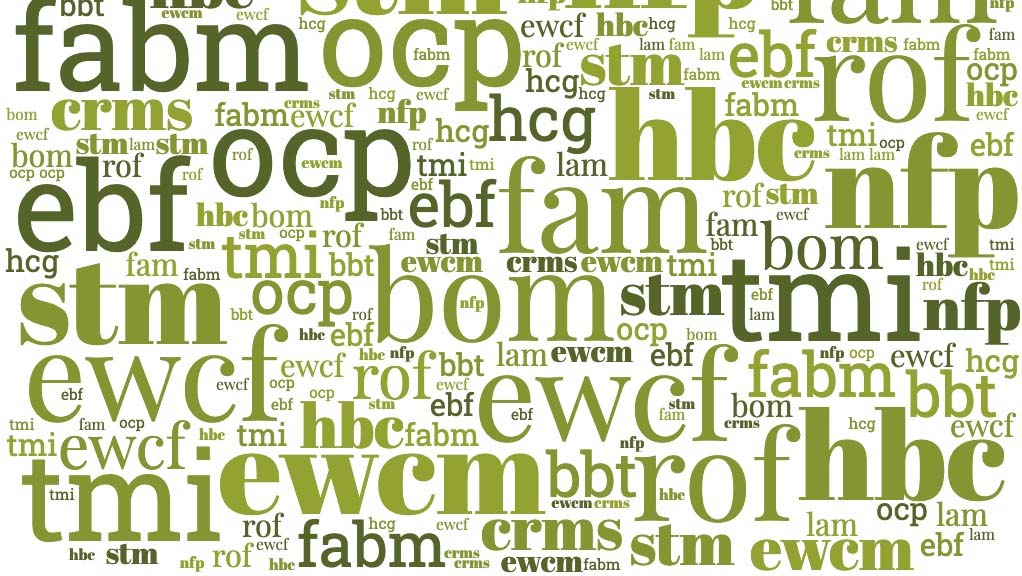Peek into an online community of women practicing natural family planning (like the Marquette Method NFP group on Facebook) and you’re likely to be taken aback by the sheer quantity of acronyms that get thrown about.
TTA? TTW? TTC?
What do they all mean?
We remember our first forays into the online world of natural family planning.
We remember the overwhelm.
We’re here to help.
Here’s your no-nonsense guide to understanding Natural Family Planning (NFP) and Fertility Awareness Methods (FAM) acronyms online.
List of Natural Family Planning (NFP) Acronyms
BBT: Basal Body Temperature
Some methods of NFP have women track their basal body temperature (BBT), which is their body temperature taken upon waking each morning. The woman tracks their daily BBT readings on a chart to identify the temperature shift which occurs during the luteal phase of the woman’s cycle. (Consult our NFP methods comparison chart to find out which methods incorporate BBT readings.)
BC: Birth Control
Birth control (BC) simply means the practice of preventing pregnancies. It’s a blanket term for all forms of contraception, hormonal and non-hormonal.
BF: Breastfeeding
Breastfeeding (BF) suppresses a woman’s fertility, at least for a time. Breastfeeding can be a difficult fertile phase to navigate with NFP—which is why breastfeeding comes up a lot in NFP groups! (Shameless plug: The Marquette Method of NFP has highly effective, research-based protocols specifically for breastfeeding women. Info here on Marquette Method for Breastfeeding Women.)
BOM: Billings Ovulation Method
The Billings Ovulation Method (BOM) is a mucus-only method of NFP. BOM users are taught to focus on the sensations that cervical mucus produces (how it feels at the vulva). You’ll see the BOM also referred to simply as “Billings.”
CD: Cycle Day
Women using NFP number the days of their cycle, beginning with “Cycle Day 1” or “CD 1.” Cycle Day 1 corresponds to the first day of a woman’s period. Keeping track of cycle days helps with calendar-based algorithms and can help women identify cycle-to-cycle patterns and irregularities.
CM: Cervical Mucus
During a typical menstrual cycle a woman’s cervical mucus (CM) undergoes significant changes, all in response to the rise and fall of estrogen levels.
Women using NFP methods that incorporate cervical mucus tracking are taught to notice its sensations (how it feels at the vulva), its characteristics or quality (how it looks, how it stretches), and its quantity (absent, present but in small quantities, or abundant).
Cervical mucus tracking is a core fertile sign and is used (either optionally or as a required fertile sign) in most modern NFP methods.
CrMS: Creighton Model FertilityCare System
The Creighton Model FertilityCare System (CrMS) is a standardization of the Billings Ovulation Method (BOM). The CrMS was developed by Dr. Thomas J. Hilgers and his team at Creighton University in Omaha, Nebraska. Creighton users record their daily external mucus observations using a detailed classification system. The CrMS is often just called “Creighton” online.
EBF: Exclusively Breastfeeding
Exclusively breastfeeding (EBF) means that a baby is getting all his or her nutrition from breastmilk—that is, the mother is not feeding her baby any baby formula or other food. This is relevant to NFP because only women who are exclusively breastfeeding are eligible to use the Lactational Amenorrhea Method (LAM) of NFP.
EWCM (or EWCF): Egg White Cervical Mucus (or Egg White Cervical Fluid)
Egg white cervical mucus (EWCM) is a specific type of cervical mucus that indicates high or peak fertility. This type of cervical mucus is clear, stretchy, and often quite abundant.
FABM: Fertility Awareness Based Methods
Fertility awareness based methods (FABMs) are family planning methods that rely on a woman observing her naturally occurring signs of fertility and infertility. Like NFP, FABMs can be used to avoid pregnancy or achieve pregnancy. The main difference between NFP and FABMs is that NFP couples who intend to avoid pregnancy are advised to abstain from intercourse during the fertile window, while couples using FABMs are advised to use an alternative form of contraception (such as condoms) if they want to engage in intercourse during the fertile window without getting pregnant. NFP methods align with Catholic Church teachings, but FABMs do not align with Catholic Church teaching because they allow barrier methods to be used.
FAM: Fertility Awareness Methods
Fertility Awareness Methods (FAMs) and Fertility Awareness Based Methods (FABMs) are the same thing. Both names and acronyms are used interchangeably.
FSH: Follicle Stimulating Hormone
Follicle Stimulating Hormone (FSH) is secreted by the brain’s anterior pituitary gland. FSH stimulates undeveloped eggs to begin developing in follicles. FSH levels can be measured with a blood test or a urine test.
HBC: Hormonal Birth Control
Hormonal birth control (HBC) refers to any form of birth control that relies on hormones to work. HBCs are often mentioned in NFP forums because it takes a while for artificial hormones to clear a woman’s system if she discontinues their use. Each NFP method has specific instructions to follow for women coming off HBCs.
HCG: Human Chorionic Gonadotropin
Human chorionic gonadotropin (HCG) is the hormone that is produced when a woman is pregnant. Pregnancy tests measure HCG levels in a woman’s urine—a positive pregnancy test means that HCG levels are elevated.
LAM: Lactational Amenorrhea Method
The Lactational Amenorrhea Method (LAM) of Natural Family Planning is specific to the first 6 months postpartum. (For further information, consult our blog post on the Lactational Amenorrhea Method.)
LMP: Last Menstrual Period
The last menstrual period (LMP) is the calendar date of the first day of a woman’s last menstrual period. If a woman is pregnant, doctors use a woman’s LMP to estimate the day of conception and to calculate a baby’s due date.
LH: Luteinizing Hormone
Luteinizing hormone (LH) breaks through the wall of the follicle and causes the egg to be released; in this way, LH is the hormone responsible for ovulation.
Women can track their LH levels in urine using single-use LH test sticks (also called Ovulation Predictor Kits or OPKs). The Marquette Method tracks LH levels using Clearblue Fertility Monitors—a peak reading on the monitor indicates that the LH surge has been identified.
LP: Luteal Phase
The luteal phase (LP) is the final phase of the menstrual cycle, measured from the day of ovulation until the final day of the cycle (the day before the woman gets her period.) It’s called the “luteal phase” because during this time the corpus luteum disintegrates.
MM: Marquette Method
The Marquette Method (MM) is a form of NFP which uses urinary hormone tests to identify the fertile window. The MM is a custom-fit method of NFP. MM users can incorporate other optional signs into the tracking routine, including CM observations, BBT measurements, or additional urinary hormone tests (such as progesterone.) The Marquette Method is one of the newest NFP methods. It was developed by Dr. Richard J. Fehring and his team at the Institute for Natural Family Planning at Marquette University in Milwaukee, Wisconsin in the early 2000s.
NFP: Natural Family Planning
The short answer to “What is Natural Family Planning (NFP)” is that it’s a general term for all methods of family planning that rely on a woman observing her naturally occurring signs of fertility and infertility.
Different NFP methods track different signs, but common ones include cervical mucus, basal body temperatures, and urinary hormone levels. NFP can be used to avoid or achieve pregnancy, depending on the couple’s intentions. (For the longer answer, see our page which explains “What is Natural Family Planning?”)
OCP: Oral Contraceptive Pill
Oral contraceptive pills (OCPs) are a form of hormonal birth control that is taken orally, by mouth. OCPs were the first kind of hormonal birth control.
OPK: Ovulation Predictor Kit
An ovulation predictor kit (OPK) is the same thing as an LH test—it tests a women’s urinary LH levels and helps her identify the LH surge in a cycle.
PP: Postpartum Period
The postpartum period (PP) begins after your baby is born. Definitions of the length of the PP vary—some consider only the first 6 weeks to be the PP while others include the first 12 months after the birth of the baby.
ROF: Return of Fertility
The return of fertility (ROF) is the day which a woman ovulates for the first time after a period of amenorrhea (absence of menstruation) … such as after lactational amenorrhea or the amenorrhea that occurs after discontinuing hormonal birth control.
TMI: Too Much Information
Not exclusive to NFP forums, this handy acronym is used to preface something that might be a little … err … sensitive for the internet. For what it’s worth, there is very little that is too much information (TMI) for your NFP instructor—we’ve heard it all. Helping you figure out things that feel pretty TMI to talk about is literally our job.
TTA: Trying to Avoid Pregnancy
This refers to the couple’s intentions for that cycle. If you see someone say “we’re TTA” that means that they’re trying to avoid pregnancy in that cycle.
TTC: Trying to Conceive
This also refers to the couple’s intentions for that cycle. Someone who is “TTC” is trying to conceive in that cycle.
TTW: Trying to Whatever
This means that the couple’s intentions are mixed—they’re not actively trying to avoid pregnancy, but they’re not actively trying to achieve pregnancy either. They’re simply … TTW!
We hope that helps demystify NFP acronyms for you! What did we miss? Send us a quick note and we’ll add it to the list!
CYA!





